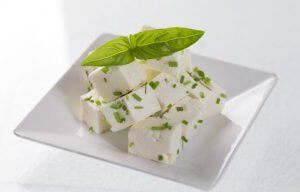Greek Salad

The Greek salad is a salad that comes from Greece and contains all of the characteristic ingredients from this country. The original salad contains tomato, cucumber, pepper, and red onion. Furthermore, the ingredients are mixed with salt, black pepper, and oregano and dressed with olive oil.
In addition to this, you can also add pieces of feta cheese, capers, and Kalamata olives. Lettuce, despite what most people think, is very rare in the Greek salad.
There is a salad option that uses lettuce and is very different, consisting of lettuce, spring onion, and fresh dill, all seasoned with olive oil and vinegar or lemon juice.
Greek salad varieties

Ingredients:
- tomato
- cucumber
- onion
- black pepper
- pepper
- feta cheese
- black olives (Kalamata)
- oregano
- oil
- capers
- salt
Directions:
As with any other salad, the preparation is very simple, we just add the ingredients to a bowl: a tomato cut into cubes, half a cucumber cut into pieces (leaving the skin), half a peeled onion chopped into pieces, black olives, pepper, capers, sliced feta cheese, and a little oregano.
Then, we spice up this Greek salad with black pepper, oil, and salt to taste. The Greek salad is a very complete recipe, and perfect for the hottest days of summer, thanks to its cooling benefits. In addition, it’s a very low-calorie recipe, because all of the ingredients are low in fat.
Feta cheese
Made with a combination of goat’s milk and sheep’s milk, feta cheese is a traditional Greek product. It has an exceptional flavor, a natural white color that isn’t the result of any bleaching process, and it’s low-fat
We can store feta cheese in wooden or aluminum containers for its ripening process. The maturation process consists of two phases. First, it’s kept in humid conditions for up to 15 days. Second, it’s stored at a controlled temperature, in a refrigerator, for 30 days. Preservatives are never used in the production of feta cheese.

Kalamata olives
The name of this variety of Greek olive originates from the region of the same name. This is where its cultivation is the most widespread.
This olive’s meatiness also gives a contrast between its sweet and salty taste and it has an almond shape. Another characteristic that differentiates this olive from others is its color. When this olive is ready for picking, its color is purple. However, these olives do change color. Particularly when they are preserved in brine, oil or wine vinegar.
The intense flavor of this olive variety makes it an ideal appetizer. But, it’s also used in a wide variety of dishes, mainly in salads, pasta or rice dishes, adding flavor and color to these recipes.
To the widely recognized gastronomic virtues of the Kalamata olive, we have to add the properties. These olives help to regulate the levels of cholesterol in our body. They also contribute high amounts of vitamin E and they are a rich source of calcium and other minerals that are beneficial for health.
The Greek salad is a salad that comes from Greece and contains all of the characteristic ingredients from this country. The original salad contains tomato, cucumber, pepper, and red onion. Furthermore, the ingredients are mixed with salt, black pepper, and oregano and dressed with olive oil.
In addition to this, you can also add pieces of feta cheese, capers, and Kalamata olives. Lettuce, despite what most people think, is very rare in the Greek salad.
There is a salad option that uses lettuce and is very different, consisting of lettuce, spring onion, and fresh dill, all seasoned with olive oil and vinegar or lemon juice.
Greek salad varieties

Ingredients:
- tomato
- cucumber
- onion
- black pepper
- pepper
- feta cheese
- black olives (Kalamata)
- oregano
- oil
- capers
- salt
Directions:
As with any other salad, the preparation is very simple, we just add the ingredients to a bowl: a tomato cut into cubes, half a cucumber cut into pieces (leaving the skin), half a peeled onion chopped into pieces, black olives, pepper, capers, sliced feta cheese, and a little oregano.
Then, we spice up this Greek salad with black pepper, oil, and salt to taste. The Greek salad is a very complete recipe, and perfect for the hottest days of summer, thanks to its cooling benefits. In addition, it’s a very low-calorie recipe, because all of the ingredients are low in fat.
Feta cheese
Made with a combination of goat’s milk and sheep’s milk, feta cheese is a traditional Greek product. It has an exceptional flavor, a natural white color that isn’t the result of any bleaching process, and it’s low-fat
We can store feta cheese in wooden or aluminum containers for its ripening process. The maturation process consists of two phases. First, it’s kept in humid conditions for up to 15 days. Second, it’s stored at a controlled temperature, in a refrigerator, for 30 days. Preservatives are never used in the production of feta cheese.

Kalamata olives
The name of this variety of Greek olive originates from the region of the same name. This is where its cultivation is the most widespread.
This olive’s meatiness also gives a contrast between its sweet and salty taste and it has an almond shape. Another characteristic that differentiates this olive from others is its color. When this olive is ready for picking, its color is purple. However, these olives do change color. Particularly when they are preserved in brine, oil or wine vinegar.
The intense flavor of this olive variety makes it an ideal appetizer. But, it’s also used in a wide variety of dishes, mainly in salads, pasta or rice dishes, adding flavor and color to these recipes.
To the widely recognized gastronomic virtues of the Kalamata olive, we have to add the properties. These olives help to regulate the levels of cholesterol in our body. They also contribute high amounts of vitamin E and they are a rich source of calcium and other minerals that are beneficial for health.
This text is provided for informational purposes only and does not replace consultation with a professional. If in doubt, consult your specialist.








